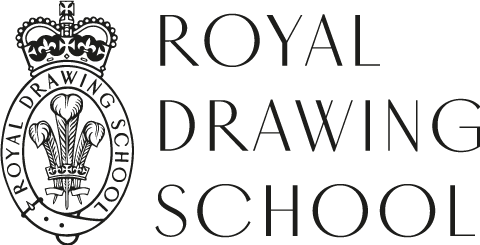Drawing from Home: Flatness and Depth
Taken from the recent publication by the Royal Drawing School, Ways of Drawing, Flatness and Depth is an exercise designed by faculty member Thomas Newbolt that focuses on drawing depth with restrictions of view.

Flatness and Depth
Where: indoors
With: large sheet of paper.
Cut a piece of paper, or join two separate pieces, to make a sheet 20 cm high and 60 cm long (approx. 8 x 24 in.)
Stand in a room and find a position from which you can see the entire space. It doesn’t matter if there are a few easels or heads blocking your view. Now, try to limit your view, seeing things that are at eye level only – this should be a band of vision approximately 20 cm high. If it helps, you can use your hands to identify this space – one hand flat above your eyes and one below, as if shielding your eyes from the sun.
Draw this narrow section of the room on the narrow sheet of paper. Make sure to draw only what is at eye level. If you rotate your body slowly through 180°, there should be no part of the drawing that is hard to see.
It will be clear almost immediately that the results of your observations form a flat band. The exercise therefore depends on your ability to show depth despite these restrictions. Try to make your drawn observations read as depth, while hopefully enjoying the beauty of their flat arrangement.
Tag us in your drawings on instagram @royaldrawingschool or Twitter @RoyalDrawing and use the hashtag #drawingfromhome so we can share your creations!

Thomas Newbolt studied at Camberwell School of Art and was Artist in Residence at Trinity College, Cambridge from 1979-81 and Harkness Fellow at the University of Virginia from 1981-83. He has taught at Camberwell, University of Wisconsin at Milwaukee 1983, Anglia Ruskin University (Cambridge School of Art) and the Royal Drawing School.
Drawings from top: Charlotte Ager, Harry Parker



